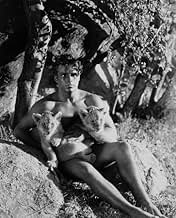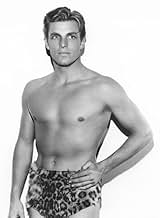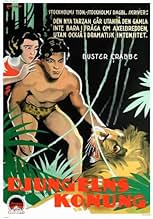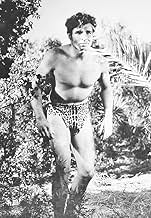IMDb-BEWERTUNG
6,2/10
257
IHRE BEWERTUNG
Füge eine Handlung in deiner Sprache hinzuA white youth who is raised in the jungle by the animals is captured by a safari and brought back to civilization as an attraction in a circus.A white youth who is raised in the jungle by the animals is captured by a safari and brought back to civilization as an attraction in a circus.A white youth who is raised in the jungle by the animals is captured by a safari and brought back to civilization as an attraction in a circus.
Douglass Dumbrille
- Ed Peters
- (as Douglas Dumbrille)
Ronnie Cosby
- Kaspa at age three
- (as Ronnie Cosbey)
Robert Adair
- John C. Knolls
- (Nicht genannt)
Florence Britton
- Mrs. Edith Knolls
- (Nicht genannt)
Don Brodie
- Reporter
- (Nicht genannt)
Leonard Carey
- Clerk at Hunting License Bureau
- (Nicht genannt)
Nora Cecil
- Spinster in Park
- (Nicht genannt)
Empfohlene Bewertungen
I saw this film only once, at the age of seven, in 1933. Even allowing for the fact that we saw fewer films then and that seven is an impressionable age,"King of the Jungle" was exceptional. Many of its powerful cinematic images have remained as active and vivid memories throughout my life, now into my 80's.
Overall the film posits a romantic, if unrealistic, idea of an intelligent, informed and physically able man who lives at ease within a natural environment and amongst its wild inhabitants. This idealised image, modified and matured over a lifetime has influenced my values and those of my family for many years. None of us can escape the thought that our environment may call us to account at any time and require us to meet similar demands.
Early in the film we see the father of a small family arranging for them to fly over a nearby jungle in a light aircraft. While he is preoccupied at the desk his small son behind him, apparently moved by curiosity, gently takes his father's knife from its sheath at the back of his belt. The knife remains with the boy long after he is the sole survivor of the subsequent plane crash in the jungle. As he grows up this tool remains his one concession to modern technology.
We see the orphaned boy playing with some young lion cubs in a clearing and when the mother lioness returns he crawls on all fours with his companions into a cave like lair, calmly followed by the lioness. We next see him fully grown, with the convincing physique of Buster Crabbe, at ease not only with lions but with all creatures. Later action-scenes illustrate and reinforce the idea of a well developed, athletic man in harmony with a respectful animal kingdom.
This happy natural order of things is shattered when Kaspa is captured by a group of hunters, commissioned by a circus to "bring back alive" a variety of wild animals. This they intend to do but his captors do not know what to make of the unique and frightening specimen, Kaspa. Stout wooden cages are erected for the different breeds on the deck of their ship and the "savage" is locked in one by himself. As the laden ship approaches its destination a customs official comes aboard to examine the cargo. He declares that Kaspa is undeniably human and must be released from his animal cage. On the instant of his release, Kaspa takes one step onto the gunwale and entirely without hesitation, dives into the sea, which of course, holds no fear for him. The shocking and explosive speed of his action remain an indelible memory.
Having thus escaped he makes for the shore and enters a comfortable dwelling which is full of strange and intriguing objects, but he is familiar enough with the contents of a goldfish bowl to take a modest drink from it. When interrupted, he hides behind a convenient screen but the lady of the house sees his bare feet under it and he is revealed. Hilarious for a seven year old! He continues to show his doubts about civilisation and his preference for things natural, but he is disarmed by the female of his species and he is persuaded to appear in a circus act with his lions. He astounds everyone when he refuses to take a pistol into the caged ring. He emerges from the action as morally superior. The film ends with Kaspa and his lady, both fully dressed in sun hats and whites, returning to the Jungle and we are left to speculate whether they can make it as its King and Queen.
Although not nominally a Tarzan film, as an evocation of the ideal of the noble savage, this memorable film is closer to the spirit of Burroughs's writing than many of the later films which bear the Tarzan title.
You will understand that I am delighted to learn that it is now possible to purchase a copy of "King of the Jungle 1933" from TVideo.com
John Fulton 2007
Overall the film posits a romantic, if unrealistic, idea of an intelligent, informed and physically able man who lives at ease within a natural environment and amongst its wild inhabitants. This idealised image, modified and matured over a lifetime has influenced my values and those of my family for many years. None of us can escape the thought that our environment may call us to account at any time and require us to meet similar demands.
Early in the film we see the father of a small family arranging for them to fly over a nearby jungle in a light aircraft. While he is preoccupied at the desk his small son behind him, apparently moved by curiosity, gently takes his father's knife from its sheath at the back of his belt. The knife remains with the boy long after he is the sole survivor of the subsequent plane crash in the jungle. As he grows up this tool remains his one concession to modern technology.
We see the orphaned boy playing with some young lion cubs in a clearing and when the mother lioness returns he crawls on all fours with his companions into a cave like lair, calmly followed by the lioness. We next see him fully grown, with the convincing physique of Buster Crabbe, at ease not only with lions but with all creatures. Later action-scenes illustrate and reinforce the idea of a well developed, athletic man in harmony with a respectful animal kingdom.
This happy natural order of things is shattered when Kaspa is captured by a group of hunters, commissioned by a circus to "bring back alive" a variety of wild animals. This they intend to do but his captors do not know what to make of the unique and frightening specimen, Kaspa. Stout wooden cages are erected for the different breeds on the deck of their ship and the "savage" is locked in one by himself. As the laden ship approaches its destination a customs official comes aboard to examine the cargo. He declares that Kaspa is undeniably human and must be released from his animal cage. On the instant of his release, Kaspa takes one step onto the gunwale and entirely without hesitation, dives into the sea, which of course, holds no fear for him. The shocking and explosive speed of his action remain an indelible memory.
Having thus escaped he makes for the shore and enters a comfortable dwelling which is full of strange and intriguing objects, but he is familiar enough with the contents of a goldfish bowl to take a modest drink from it. When interrupted, he hides behind a convenient screen but the lady of the house sees his bare feet under it and he is revealed. Hilarious for a seven year old! He continues to show his doubts about civilisation and his preference for things natural, but he is disarmed by the female of his species and he is persuaded to appear in a circus act with his lions. He astounds everyone when he refuses to take a pistol into the caged ring. He emerges from the action as morally superior. The film ends with Kaspa and his lady, both fully dressed in sun hats and whites, returning to the Jungle and we are left to speculate whether they can make it as its King and Queen.
Although not nominally a Tarzan film, as an evocation of the ideal of the noble savage, this memorable film is closer to the spirit of Burroughs's writing than many of the later films which bear the Tarzan title.
You will understand that I am delighted to learn that it is now possible to purchase a copy of "King of the Jungle 1933" from TVideo.com
John Fulton 2007
During the 1930s-60s, Hollywood made a ton of Tarzan and Tarzan knockoff movies. A few of the Tarzan films (especially the ones with Johnny Weissmuller) were excellent...and most of the rest were pretty crappy...particularly the knockoffs. These knockoff and crappy Tarzan pics abound with terrible stock footage (often of animals not even native to Africa) and the plots are, to put is charitably, pretty dull. In light of this, I was shocked how much I enjoyed "King of the Jungle", a knockoff all the way...but a wonderful knockoff.
The story starts out pretty much like Tarzan. Some parents bring their very young child to the African savannahs in order to go sightseeing. However, they are killed and the child is but a toddler. But instead of apes adopting the child, it's adopted by a lioness!! Now don't start complaining about how 'that's not possible'....it's not like it's very likely gorillas would successfully raise a child either!
The child grows into a man (Buster Crabbe) and he is at home with all the lions. However, when some folks come to the savannah looking for lions, they accidentally also capture the young man. He is given the name 'Kaspa the Lion Man' and is taken to America in a cage!! Not surprisingly, he soon escapes but manages to meet a nice lady (Frances Dee) and she is able to convince him to go back with the folks...and she is hired to take care of him. Soon, Kaspa has learned to talk and is a bright, handsome guy....and he has a strong affinity for lions. He becomes the ultimate circus lion tamer--doing his job with no whip, no chair, no gun...just love for the animals. What's next? See the film....you won't be unhappy.
This film is not without problems. The most obvious is the similarlity to Tarzan. It's too similar in spots and is truly a knockoff. There also are some godawful staged fights...such as when they have a bull and lion spar each other as well as later in the film when a lion and tiger fight. I don't think any of the animals were killed or seriously injured....at least in the footage you see...though it is cruel and irresponsible. However, it also has some amazingly good qualities....no crappy stock footage(!!!), a breathtaking finale at the circus as well as a wonderful and sweet ending. Overall, a lot more good than bad in this one...and it's no wonder Crabbe's next film was a movie serial...."Tarzan the Fearless".
The story starts out pretty much like Tarzan. Some parents bring their very young child to the African savannahs in order to go sightseeing. However, they are killed and the child is but a toddler. But instead of apes adopting the child, it's adopted by a lioness!! Now don't start complaining about how 'that's not possible'....it's not like it's very likely gorillas would successfully raise a child either!
The child grows into a man (Buster Crabbe) and he is at home with all the lions. However, when some folks come to the savannah looking for lions, they accidentally also capture the young man. He is given the name 'Kaspa the Lion Man' and is taken to America in a cage!! Not surprisingly, he soon escapes but manages to meet a nice lady (Frances Dee) and she is able to convince him to go back with the folks...and she is hired to take care of him. Soon, Kaspa has learned to talk and is a bright, handsome guy....and he has a strong affinity for lions. He becomes the ultimate circus lion tamer--doing his job with no whip, no chair, no gun...just love for the animals. What's next? See the film....you won't be unhappy.
This film is not without problems. The most obvious is the similarlity to Tarzan. It's too similar in spots and is truly a knockoff. There also are some godawful staged fights...such as when they have a bull and lion spar each other as well as later in the film when a lion and tiger fight. I don't think any of the animals were killed or seriously injured....at least in the footage you see...though it is cruel and irresponsible. However, it also has some amazingly good qualities....no crappy stock footage(!!!), a breathtaking finale at the circus as well as a wonderful and sweet ending. Overall, a lot more good than bad in this one...and it's no wonder Crabbe's next film was a movie serial...."Tarzan the Fearless".
Paramount's answer to Tarzan, with Olympic athlete Buster Crabbe as a child raised to adulthood by a pride of lions. The expected complications result when Buster and his furry pals are transported to a circus. Charmingly clumsy in its early scenes, the film builds to an exciting, fiery conclusion. Animal activists will wince at a brutal battle between some big cats, but otherwise it's very entertaining.
Jumping on the bandwagon in Hollywood can produce almost guaranteed profits at the box office. When 1932's "Tarzan The Ape Man" with Johnny Weissmuller became such a huge hit, Paramount Pictures began looking for a similarly-themed vehicle to hitch its wagon. The studio found it in the form of Buster Crabbe in March 1933's "King of the Jungle." Paramount researchers found a book resembling Edgar Rice Burroughs' Tarzan series in Charles Thurley Stoneham's 1931 'The Lion's Way,' about a boy whose parents get killed on a Kenyan trip and is raised by lions. Paramount copied Tarzan's recruitment process by scouting for a potential lead actor by looking at the athletes competing in the nearby Los Angles 1932 Olympic Games. Canvasing forty competitors at the games, Paramount executives chose one after a series of screen tests: Clarence Linden Crabbe..
Crabbe's role as Kaspa the Lion Man in "King of the Jungle" began an 180 film and television show career that lasted through the early 1980s. He was especially popular in a number of film series, earning the moniker "King of Serials," playing such famous characters as Flash Gordon, Buck Rogers, Billy the Kid, and even Tarzan himself. Going by his nickname Buster, Crabbe was humbled about his acting talent. "Some say, that my acting rose to the point of incompetence and then leveled off," he said in retrospect.
He remembered auditioning for the Kaspa part. "Just before the Olympics we went down to be tested," Crabbe said. "They had us all throw a spear and pick up a paper-mache rock. About three days after the Olympics they called me back. I finally got the part." Crabbe, who grew up in Hawaii and attended the University of Southern California, excelled in swimming, earning the bronze medal in the 1928 Summer Olympics in Amsterdam, the same games where Johnny Weismuller, the first talking Tarzen on the screen, won two gold medals in swimming. In the 1932 games, Crabbe won the gold in the 400 meters freestyle by one-tenth of a second. "That one-tenth of a second changed my life," recalled Crabbe. "It was then the Hollywood scouts discovered latent histrionic abilities in me." What differentiated "King of the Jungle" to "Tarzan the Ape Man" was Crabbe's character, the African-raised Kaspa, ends up spending most of his time in the United States after his capture by two white game hunters, who sell him to an American promoter. Kaspa isn't the animal fighter that Tarzan was. Just before arriving on the United States shores to be a showman messing around with lions, he escapes. Kaspa meets his 'Jane," Ann Rogers (Frances Dee), when he climbs through an apartment window to steal her and her roommates' food on the dinner table while clothed just in his loin cloth. Ann gets friendly with Kaspa and teaches him English. She has to start from Ground Zero to show him some lessons in civilized conduct before he's hired as a circus lion tamer. His job sets up the exciting conclusion where a spectacular fire runs throughout the circus tents, threatening his best friends, the lions.
Crabbe's competent acting and strong physic, one he maintained throughout his early 70s by swimming two miles a day partly to alleviate his arthritis, assured the actor a busy and rewarding acting career. Late in life, Crabbe, half-kidding, said he made only one A-movie and the "rest falling at least one letter lower in the alphabet."
Crabbe's role as Kaspa the Lion Man in "King of the Jungle" began an 180 film and television show career that lasted through the early 1980s. He was especially popular in a number of film series, earning the moniker "King of Serials," playing such famous characters as Flash Gordon, Buck Rogers, Billy the Kid, and even Tarzan himself. Going by his nickname Buster, Crabbe was humbled about his acting talent. "Some say, that my acting rose to the point of incompetence and then leveled off," he said in retrospect.
He remembered auditioning for the Kaspa part. "Just before the Olympics we went down to be tested," Crabbe said. "They had us all throw a spear and pick up a paper-mache rock. About three days after the Olympics they called me back. I finally got the part." Crabbe, who grew up in Hawaii and attended the University of Southern California, excelled in swimming, earning the bronze medal in the 1928 Summer Olympics in Amsterdam, the same games where Johnny Weismuller, the first talking Tarzen on the screen, won two gold medals in swimming. In the 1932 games, Crabbe won the gold in the 400 meters freestyle by one-tenth of a second. "That one-tenth of a second changed my life," recalled Crabbe. "It was then the Hollywood scouts discovered latent histrionic abilities in me." What differentiated "King of the Jungle" to "Tarzan the Ape Man" was Crabbe's character, the African-raised Kaspa, ends up spending most of his time in the United States after his capture by two white game hunters, who sell him to an American promoter. Kaspa isn't the animal fighter that Tarzan was. Just before arriving on the United States shores to be a showman messing around with lions, he escapes. Kaspa meets his 'Jane," Ann Rogers (Frances Dee), when he climbs through an apartment window to steal her and her roommates' food on the dinner table while clothed just in his loin cloth. Ann gets friendly with Kaspa and teaches him English. She has to start from Ground Zero to show him some lessons in civilized conduct before he's hired as a circus lion tamer. His job sets up the exciting conclusion where a spectacular fire runs throughout the circus tents, threatening his best friends, the lions.
Crabbe's competent acting and strong physic, one he maintained throughout his early 70s by swimming two miles a day partly to alleviate his arthritis, assured the actor a busy and rewarding acting career. Late in life, Crabbe, half-kidding, said he made only one A-movie and the "rest falling at least one letter lower in the alphabet."
No, this is not a Tarzan film; the name of the hero here is Kaspa (and it is not a ghost movie, either). Kaspa was raised by lions and trapped by white bwanas to be taken back to New York (like King Kong). Some of the scenes are quite remarkable; especially ones with the young child Kaspa in the beginning of the film. However, the film could not possibly have the disclaimer that no animals were hurt or killed in the filming of this movie. Other than that unpleasant caveat, the film is immensely entertaining and good fun for the whole family.
Wusstest du schon
- WissenswertesBuster Crabbe narrowly lost the role of Tarzan to Johnny Weissmuller, so he starred in this Tarzan "copycat" film.
- PatzerBiggest plot hole is that a human being can not be bought and sold else it is human trafficking, illegal under international law. Also he could not enter or leave any country without a passport.
- VerbindungenEdited into Caged Fury (1948)
Top-Auswahl
Melde dich zum Bewerten an und greife auf die Watchlist für personalisierte Empfehlungen zu.
Details
- Laufzeit1 Stunde 13 Minuten
- Farbe
- Seitenverhältnis
- 1.37 : 1
Zu dieser Seite beitragen
Bearbeitung vorschlagen oder fehlenden Inhalt hinzufügen

Oberste Lücke
By what name was Tarzan der Löwenmann (1933) officially released in India in English?
Antwort


































